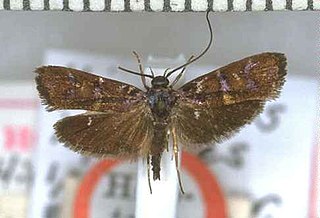
Bascantis is a genus of moths belonging to the family Tineidae. It contains only one species, Bascantis sirenica, that is endemic to New Zealand. This species is classified as "Data Deficient" by the Department of Conservation.

Hierodoris iophanes is a moth of the family Oecophoridae. It was described by Edward Meyrick in 1912. This species can be distinguished from others in its genus by the purple metallic colouration as well as the blue-white mark on its forewings. It is endemic to New Zealand, where it has been recorded from Auckland to Southland. This species inhabits native forest or scrub, with the adults preferring open glades. They are known to be on the wing from November until February and fly during daylight hours, being active on hot sunny days. Larvae feed on the interior of twigs of Prumnopitys ferruginea. The twigs had evidence of oviposition scars of cicadas and the larvae were collected in October after reddish-brown frass indicated their location within the twigs.
Charistica ioploca is a moth in the family Gelechiidae. It was described by Edward Meyrick in 1922. It is found in Amazonas, Brazil.
Charistica callichroma is a moth in the family Gelechiidae. It was described by Edward Meyrick in 1914. It is found in Guyana and possibly Amazonas, Brazil.
Charistica iriantha is a moth in the family Gelechiidae. It was described by Edward Meyrick in 1914. It is found in Guyana and Peru.
Charistica sandaracota is a moth in the family Gelechiidae. It was described by Edward Meyrick in 1914. It is found in Guyana.
Charistica rhodopetala is a moth in the family Gelechiidae. It was described by Edward Meyrick in 1922. It is found in Amazonas, Brazil.
Battaristis syngraphopa is a moth of the family Gelechiidae. It was described by Edward Meyrick in 1922. It is found in Brazil and Peru.
Cerconota rosacea is a moth of the family Depressariidae. It is found in the Amazon region and French Guiana.
Deltoplastis figurata is a moth in the family Lecithoceridae. It was described by Edward Meyrick in 1910. It is found in Sri Lanka.
Deltoplastis straminicornis is a moth in the family Lecithoceridae. It was described by Edward Meyrick in 1910. It is found in Sri Lanka.
Cladophantis spilozeucta is a moth in the family Xyloryctidae. It was described by Edward Meyrick in 1927. It is found in South Africa.
Idiocrates is a monotypic moth genus in the family Depressariidae. Its only species, Idiocrates balanitis, is found in Bolivia. Both the genus and species were first described by Edward Meyrick in 1909.
Antaeotricha nitescens is a species of moth in the family Depressariidae. It was described by Edward Meyrick in 1925. It is found in Brazil (Para).
Antaeotricha desecta is a moth in the family Depressariidae. It was described by Edward Meyrick in 1918. It is found in French Guiana.

Phylomictis maligna is a moth in the family Depressariidae. It was described by Edward Meyrick in 1890. It is found in Australia, where it has been recorded from Victoria.
Stenoma chionogramma is a moth in the family Depressariidae. It was described by Edward Meyrick in 1909. It is found in Brazil (Amazonas), Peru and Bolivia.
Chlamydastis epophrysta is a moth in the family Depressariidae. It was described by Edward Meyrick in 1909. It is found in Peru.
Imma tetrope is a moth in the family Immidae. It was described by Alexey Diakonoff in 1978. It is found in Nepal.
Imma thianthes is a moth in the family Immidae. It was described by Edward Meyrick in 1927. It is found on New Ireland and New Hanover.


